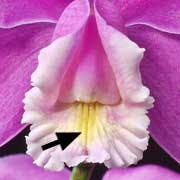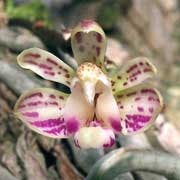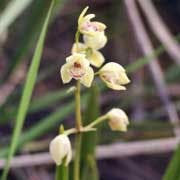K
karyology (cair-ee-OLL-oh-gee) The science of studying chromosome morphology.
karyotype (CAIR-ee-oh-type) The morphologic type or characterization of the chromosome complement.
keel: Keels on the midlobe of the lip identify C. harrisoniana.

keel (keel) A central dorsal ridge, like the keel of a boat.
keeled (keel-d) Provided with a keel.
Kefersteinia (kef-er-STINE-ee-a) There are around 20 epiphytic species in this genus ranging from Costa Rica south to Bolivia. H.G. Reichenbach created the genus in 1852, naming it in honor of Herr Keferstein of Krollwitz, an avid orchid grower and friend of Reichenbach.
Kegeliella (keg-el-ee-EL-a) The two species in this genus are found in Central America, West Indies and Surinam. H.G. Reichenbach established the genus in 1852, naming it Kegelia, in honor of Herr Kegel, the gardener at Halle University in Germany, but Mansfield, in 1934, discovered that the name had been used previously for another genus and changed it to Kegeliella.
Kingella (king-EL-a) See Kingidium.
keiki(KAY-kee) Hawaiian term used by orchidists to signify an adventitious offshoot or offset from an orchid's cane or inflorescence.
key (KEE) A series of paired, contrasting statements used to facilitate identification.
King, George (1840—1909) British botanist, co-author with Robert Pantling of the monumental The Orchids of the Sikkim-Himalaya.
Kingdon-Ward, F. (1885—1958) Indefatigable British plant collector, responsible for numerous horticultural introductions from Asia including the eponymous Paphiopedilum wardii.
Kingidium: Kingidium mimus was recently transferred into Phalaenopsis.

Kingidium (king-ID-ee-um) There are approximately five epiphytic species in this genus ranging from India east to the Philippines. P.F. Hunt established the genus in 1970, naming it in honor of Sir George King, the coauthor of Orchids of Sikkim-Himalaya. Recent studies by Christenson transfer this genus to Phalaenopsis.
Klaboch, Franz (?-1879) A nephew of Benedict Roezl, he collected orchids for a few years for the firm of Sander, chiefly in Colombia, and with his brother is commemorated in the species Pescatorea klabochorum.
Knudson, Lewis (1884—1958) An American plant physiologist, long associated with Cornell University, noted for his work in the development of the asymbiotic method of germinating orchid seed; in 1949, he was awarded the American Orchid Society's Gold Medal of Achievement for his contributions to orchidology.
Kollenstenia: Kollenstenia kellnereana growing as a terrestrial in Venezuela.

Koellensteinia (kehl-en-STINE-ee-a) The 10 species in this genus, widespread in South America, grow either terrestrially or epiphytically. Schlechter established the genus in 1918, naming it in honor of Captain Kellner von Koelenstein, an Austrian.
Kraenzlin, Fritz (1847—1934) A German orchidologist whose work embraced miscellaneous new orchid species from Tibet, China, the Pacific Islands, Africa and the Americas. He is noted chiefly for his substandard monographic treatment of large and difficult groups of orchids, such as the Coelogyninae, the Dendrobiinae, the Oncidiinae, Masdevallia and Polystachya.








